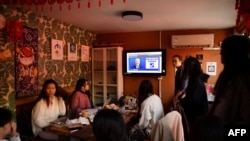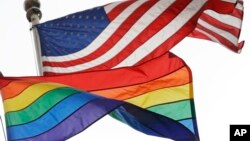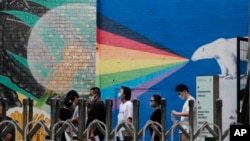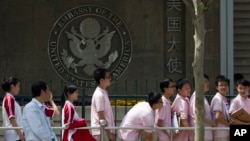Student Union
Chinese, Indian Students Make Up Half of Foreign Students in US

Students from China and India comprise half of all international students in the U.S., propelled by increased wealth in those countries and drawn by potential employment in America, education and immigration experts told VOA.
“The ratios are due largely to external demographic, geopolitical, and economic factors,” said Rachel Banks, senior director of public policy and legislative strategy at NAFSA: Association of International Educators. “It is largely driven by who can afford the cost of studying in the United States, as international students are not eligible for federal financial aid.”
China’s economy has grown markedly since opening to international trade in the 1970s and now stands as the second largest with a growing and more affluent middle class that can afford a foreign education.
“Manufacturing growth in China has raised a lot of Chinese incomes,” said Gaurav Khanna, an assistant professor of economics at the University of California-San Diego. “Now they can afford to come to the U.S.”
Chinese and Indian enrollment at U.S. colleges and universities swooped upward at the turn of the new century. In 2000, there were nearly 60,000 Chinese students in the U.S., and nearly 55,000 students from India. Student enrollment in U.S. schools from Japan and South Korea were not far behind.
By 2010, Chinese student enrollment had grown to almost 158,000 students in the U.S., with nearly 104,000 students from India, pulling far ahead of South Korea’s 73,000 students. Other nations sent even fewer.
In 2020, before drastic enrollment reductions due to the COVID-19 pandemic, there were more than 372,000 Chinese and 193,000 Indian students in the U.S., or 34% and 18%, respectively, of the 1,075,496 international students in the U.S., according to the Institute for International Education (IIE) headquartered in New York. Students from South Korea had dropped back to a distant third, sending close to 50,000, or 4.6% of the total in the U.S.
“China and India are the two most populous nations on the planet, and they generate large numbers of college-prepared students at a rate that their own higher education systems cannot meet,” Banks said. “So many students look abroad for higher education opportunities.”
“Until very recently, they didn't have kind of the next tier of good colleges in China,” said Khanna. “So students who couldn't get into the top, the top universities in China, would just say, let me go abroad.”
Bella Du, a recent Chinese graduate from American University in Washington, confirms Khanna’s explanation.
“More Chinese students want to study abroad, and America offers the opportunity of a very high-end university and resources that it provides,” she said.
When international students come to the U.S. for higher education, they bring billions in revenue — $41 billion in 2018-2019 — to the U.S., concentrated in regions where they are clustered: California, New York, New England (Massachusetts and Rhode Island), Upper Midwest (Illinois, Indiana, Wisconsin, Michigan), Texas, Washington D.C. and Washington state.
Their career paths are clustered, too: 77% of international students specialize in science, technology, engineering and math (STEM), which includes health professions.
“STEM (science, technology, engineering and math) and health research are more advanced in the U.S. than in most other countries,” said Arun Krishnavajjala, an Indian student earning his Ph.D. in computer science at George Mason University in Virginia. “STEM jobs, in particular, are fueled by big tech, and most of the largest tech companies reside in the U.S., therefore, almost always requiring a U.S.-based educational requirement.”
A majority of international students, not only Chinese or Indian, cite immigration pathways to employment as one of the top reasons for studying in the U.S.
“A lot of Indian students essentially use the U.S. education system as a way to gain access to the U.S. labor market,” said Khanna. “If you come and do your education in the U.S., then you're going to get hired from the campus in the U.S. essentially.”
While H1-B visas are highly coveted by foreign workers, they are not easy to get. Last year, 65,000 were available, with 20,000 additional issued to foreigners with a master’s degree or who graduated from a U.S. university, according to the American Immigration Council.
Without an H1-B visa, international students who have graduated or exhausted the Optional Practical Training (OPT) visa — which allows them to stay up to three years after graduation — cannot legally work in the U.S.
“I think it is hard for international students to find jobs in the United States if you do not have a green card,” said, Du, referring to legal permanent residency in the U.S. “So I think it only depends on the resources and opportunities. If I find a job here then I will stay in the United States if I don’t then I will go back to China.”
Krishnavajjala, who is in the U.S. on a student visa, agrees.
“This is an issue a lot of immigrants face. Green cards take decades to get now and the government's banter about legal and illegal immigrants leaves immigrants who have lived here their entire life here in limbo about their future,” he said. “The government's incompetence in immigration in the last decade has put people like me in a situation of paying international tuition and fearing deportation every year.”
Some experts suggest that another reason the U.S. admits high numbers of Chinese students is to expose them to American democracy.
“Chinese and Russian students always learn a great deal about American democracy and other aspects of our society when they come here, and they take that knowledge back home with them,” wrote former Ambassador William A. Rugh in American Diplomacy in August 2020.
“Exposure to our ‘soft power’ has more impact on them than any imagined negative impact they might have on Americans,” wrote Rugh, who served as a U.S. foreign service officer from 1964 to 1995.
Critics, however, see allowing a large Chinese student presence as enabling espionage and the theft of U.S. intellectual property, especially in technology and medical research.
In June, a bipartisan bill, the Safeguarding American Innovation Act, was introduced in the U.S. Senate. The legislation aims to prevent foreign competitors such as China from stealing intellectual property developed at U.S. colleges and universities by mandating additional scrutiny of applications for U.S. visas as well as federal research grants.
See all News Updates of the Day
- By Dylan Ebs
International students find community during Pride Month

For LGBTQ+ international students, Pride Month, observed in June, is a unique time to reflect.
They hold on to multiple identities — both their LGBTQ+ identity and their cultural background — but coming to terms with them is not always easy.
For graduate student David Zhou, these identities can feel conflicting as transgender rights in China remain a controversial issue and spaces for LGBTQ people close. Zhou, 25, is transgender and pursuing an education in the STEM field at an urban university in the Midwestern United States.
VOA is using a pseudonym for Zhou’s first name and is not naming his university to protect his identity due to safety concerns back home in China. Zhou is not open about his transgender identity to his family.
During Pride Month, Zhou said he attended multiple LGBTQ+ events in his community and is surrounded by a supportive group of LGBTQ+ students who can relate to his experiences. But he’s not open about his identity to everyone on campus and said he doesn’t disclose his preferred pronouns to everyone to avoid transphobic comments.
“I feel like I have to make some judgments of the character of that person to see if they’re a good person to disclose [my identity] to,” Zhou said.
Zhou’s Pride Month celebrations included attending local markets with LGBTQ+ vendors and hanging out with his LGBTQ+ friends.
“They normalized being trans and for a long time I feel like trans identity is, should I say a vulnerability, brings me fear and worrying about discrimination, but having those events are helpful because it allowed me to see that queer people could just [live] openly,” he said.
At social events where few international students are present, Zhou said it can be tough to fit in.
“There's a lot of times like when they were talking about things I kind of, don't really understand, mostly because I kind of lack some background experience or knowledge,” he said.
Zhou said he is not aware of specific groups for LGBTQ+ international students at his university, but said international students are more prevalent in graduate programs and therefore find representation in organizations for LGBTQ+ graduate students.
In China, transgender individuals must obtain consent from an “immediate family member,” even for adults hoping to transition, which critics say limits the autonomy of transgender individuals while supporters say the policy protects doctors from violence by upset parents.
Struby Struble, a former coordinator of the University of Missouri LGBTQ+ Resource Center, told NAFSA: Association of International Educators in 2015 that LGBTQ+ international students face a “double barrier” on campus.
“With their international student friends, they feel isolated because they’re the LGBT one,” she said. “But then among the LGBT students on campus, they feel isolated because they’re the international one.”
Nick Martin, associate director of the Q Center, Binghamton University’s LGBTQ+ student support office, said when international students tour the center, there’s often a sense of hesitation as they enter a type of space that may not be present in their home country.
“I compare that to a year in after they've come into the space, they've again, maybe come to some of our events, they've got more connected,” he said.
Martin said graduate students have a unique interest in the Q Center as they may use the office for research and advocacy purposes that align with their studies.
“For older students, there may be hesitancy in a different way, but I think it's more in the vein of they want to do some of the advocacy work,” he said.
Martin said he thinks about how both his office and BU’s international student office can support students who come from countries with few — if any — protections for LGBTQ+ individuals.
“It's been a learning process of what those students really need, but I think I've kind of learned that a lot of students are just looking for the safe space that we offer,” Martin said.
- By VOA News
International students discuss US campus culture shock

International students at De Anza College in Cupertino, California, talked about culture shock in an article in La Voz News, the student newspaper.
"It felt like a major culture shock. Everything was so different, from academics to mannerism," said a student from Mexico.
Read the full story here.
These are the most expensive schools in the US

High tuition costs along with housing and food expenses can add up for students at U.S. colleges and universities.
MSNBC looked at the most expensive schools in the country, with one costing more than $500,000 for a bachelor’s degree. (June 2024)
Uzbekistan students admitted into top US universities

Students from Uzbekistan are among the international students admitted to top colleges and universities in recent years.
Gazata.uz profiled some of the Uzbekistan students attending Harvard, Brown, Princeton and other U.S. universities. (June 2024)
- By Stella Hsu
Reports of visa checks, deportations worry Chinese STEM students in US

Geopolitical tensions and growing competition in tech between the United States and China appear to be spilling over into academia despite commitments from the world’s two biggest economies to boost people-to-people exchanges.
The United States remains the top choice for Chinese students seeking to study abroad with nearly 300,000 studying in American colleges and universities during the 2022-2023 school year. But reports of some cases that students and professors are facing extra scrutiny while passing through immigration and the deportation of others are raising concerns.
For Chen Xiaojin, a doctoral student studying semiconductor materials at a university in the Washington, D.C., metropolitan area, it has been six years since she returned to her hometown of Beijing.
At first, it was the COVID-19 pandemic that kept her from going home. But over the past two years, she has been deterred by accounts of Chinese students majoring in science and engineering being required to reapply for their visas upon returning to China.
She also says she is worried by reports over the past six months of Chinese students being deported, even at nearby Dulles Airport.
"My current research is relatively sensitive, and my boss [adviser] is getting funds from the U.S. Department of Defense, making it even more sensitive,” she told VOA. "I am afraid that I won't be able to return after I go back [to China]."
Chen says that if she did return to China, she would have to apply for a new visa.
In a report late last month, Bloomberg said it had found at least 20 Chinese students and scholars with valid visas who were deported at U.S. Customs since November and barred from reentry. The U.S. Customs and Border Protection Agency does not release relevant data.
Immigration attorney Dan Berger represented one Chinese student who was deported late last year. He tells VOA Mandarin that the student studied biological sciences at Yale University and was about to complete her doctorate.
She visited her family in China and got a new visa but was deported by customs at Dulles Airport and barred from reentering the country for five years. Berger said he did not see anything suspicious in the transcript of the conversation between the student and the customs officer.
"We have seen what seems like a pattern over the last six months of Chinese PhD students being turned around…. more than I've seen in quite a while," he said.
Matthew Brazil, a fellow at the Jamestown Foundation, said neither country seems willing to explain the situation. However, he believes that in most cases, the United States must have valid reasons for blocking visa holders from entering the country.
In some cases, the student’s background may not match what is written on the visa application. In other cases, customs agents may also find something that the State Department missed, and once they see it, they are responsible for taking action.
"I wish the Chinese side would be specific about their students who were refused entry,” he said. “The fact that both sides are mum on details and that the Chinese side is engaged with the usual angry rhetoric means that each has security concerns. And that says to me that there was good reason for the U.S. to stop these particular applicants."
Brazil also sees a connection between the entry denials and export control regulations issued by the United States in October 2022 that restrict China's ability to obtain advanced computing chips, develop and maintain supercomputers, and manufacture advanced semiconductors.
U.S. Customs and Border Protection is one of the law enforcement agencies authorized to investigate violations of export control regulations, he said.
"Beijing's intelligence agencies are known to focus attention on PRC [People's Republic of China] students and scientists headed abroad who study or work on dual-use technologies controlled under the Export Administration Act — compelling Chinese students and scientists to report on what they've learned when they return to China on holiday,” he said. “This has been true for decades."
Bill Drexel, a fellow for the Technology and National Security Program at the Center for a New American Security, said the U.S. government did find some cases where students tried to steal strategic technology for China.
"I think it would both not be surprising that they found some really questionable or incriminating evidence for some students,” he said. “It would also not be surprising if, in their hunt for really solid evidence, they also may have made some mistakes on other students.”
Drexel adds that “it’s just kind of an unfortunate fact of the time that we live in and the tactics that the CCP uses when it comes to these measures."
In a post on X in early May, U.S. ambassador to China Nicholas Burns tried to dispel concerns about visas and entry to the United States for students and scholars. In the post, he said "99.9% of Chinese students holding visas encounter no issues upon entering the United States.”
In an interview with The Wall Street Journal Monday, Burns said it is China that is making it impossible to promote people-to-people ties. Burns told the Journal that students attending events sponsored by the United States in China have been interrogated and intimidated.
He also said that since U.S. President Joe Biden and China’s leader Xi Jinping held their summit in San Francisco last year, China’s Ministry of State Security and other agencies had interfered with Chinese citizens’ participation at some 61 events.
At a regular briefing on Wednesday, Chinese Foreign Ministry spokesperson Mao Ning dismissed those accusations, saying that they did not “reflect reality" and that went against key understandings reached by both countries’ presidents in San Francisco.
“The United States, under the pretext of 'national security,' unjustifiably harasses, interrogates, and deports Chinese students in the U.S., causing them significant harm and creating a severe chilling effect,” Mao said. “The image of the United States in the minds of the Chinese people fundamentally depends on the actions of the United States itself.”
Drexel said he believes Burns’ comments about visas and students' willingness to study in the U.S. still ring true.
“On balance, it's still the case that American universities are overwhelmingly warm towards Chinese students and want them in large numbers," he said.
However, Berger, the immigration lawyer, is concerned about the chilling effect recent cases involving Chinese students could have.
"In general, we are being more careful about advising Chinese graduate students in STEM fields about traveling and letting them know that there is some small risk,” he said.
Even though the risk is small, it does seem to be real at the moment, he said.
Adrianna Zhang contributed to this report.













